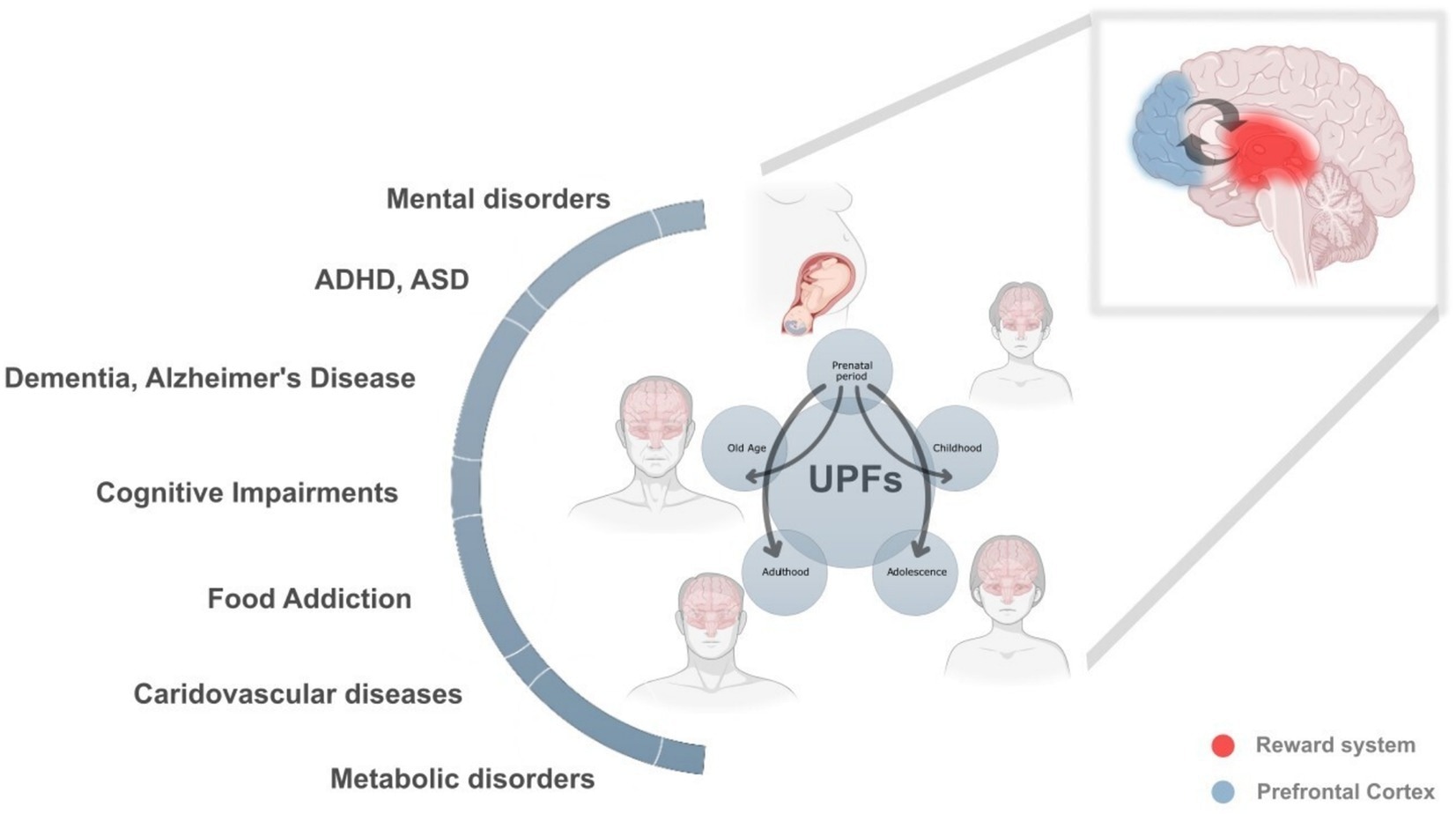A major review finds that diets high in ultra-processed foods may rewire the developing brain, amplifying risks for ADHD, depression, and even dementia, spotlighting the urgent need to rethink what children and expectant mothers eat.
 Review: The consequences of ultra-processed foods on brain development during prenatal, adolescent and adult stages. Image Credit: Lightspring / Shutterstock
Review: The consequences of ultra-processed foods on brain development during prenatal, adolescent and adult stages. Image Credit: Lightspring / Shutterstock
In a recent review article published in the journal Frontiers in Public Health, researchers in Switzerland examined the impacts of consuming ultra-processed foods (UPFs) on brain function and development during the critical periods of childhood, adolescence, and pregnancy.
Their conclusions raise concerns that exposure to UPFs during early life could impair cognitive development and increase risks to long-term mental health, including neurodevelopmental disorders such as ADHD and ASD, and later-life risks such as dementia and Alzheimer’s disease. The review also describes habitual overconsumption and reward dysfunction related to UPF-driven changes in brain reward circuitry, though it does not explicitly characterize these as “addiction-like eating behaviours.” This highlights the urgent need for public health strategies targeting maternal and child nutrition.
Growing concerns over UPFs
UPFs, which are energy-dense products high in unhealthy fats, salt, and sugar, have become a major part of modern diets and are increasingly being linked to mental disorders, metabolic disease, and obesity.
While effects on adults are well-documented, the impact of UPFs on brain development during vulnerable life stages, such as early childhood, adolescence, and pregnancy, is less understood.
The development and spread of convenience foods began in the mid-20th century, with products like frozen dinners and the introduction of microwaves boosting their popularity.
By the 1980s, concerns over health impacts began to grow, and in 2009, the NOVA classification system formally defined UPFs, distinguishing them from minimally processed and whole foods.
UPFs are designed for palatability, affordability, and long shelf life, but are nutritionally poor and often contain additives and harmful byproducts from processing and packaging. The NOVA system groups foods into four categories based on processing levels, with UPFs being the most altered and least nutritious.
UPFs now account for more than half of dietary energy intake in many developed nations, with consumption also rising in middle-income countries.
Of particular concern is the increasing intake among children and adolescents, a population highly susceptible to nutritional deficiencies. This trend could have profound effects on brain development and mental health, as well as exacerbate sensory-driven selective eating behaviours (such as those seen in ARFID), a selective eating disorder that the review discusses in the context of UPFs' uniform texture and sensory properties but does not causally link to UPF consumption. Such effects may reinforce a cycle of poor health outcomes across generations.
Given the complexity of brain maturation and the role of nutrition in shaping outcomes throughout one’s life, understanding the impacts of UPFs on neurodevelopment is crucial.
 The lifelong and intergenerational impact of ultra-processed foods (UPFs) on health and neurodevelopment. This figure illustrates the profound and cumulative effects of UPF consumption across different life stages, prenatal period, childhood, adolescence, adulthood, and old age, highlighting their role in a broad spectrum of neurodevelopmental, metabolic, cardiovascular, and cognitive disorders. The interconnected arrows emphasize how exposure to UPFs in one stage can amplify health risks in later stages, creating a continuous and reinforcing cycle of adverse health outcomes.
The lifelong and intergenerational impact of ultra-processed foods (UPFs) on health and neurodevelopment. This figure illustrates the profound and cumulative effects of UPF consumption across different life stages, prenatal period, childhood, adolescence, adulthood, and old age, highlighting their role in a broad spectrum of neurodevelopmental, metabolic, cardiovascular, and cognitive disorders. The interconnected arrows emphasize how exposure to UPFs in one stage can amplify health risks in later stages, creating a continuous and reinforcing cycle of adverse health outcomes.
Health consequences of UPF consumption
Large-scale studies consistently tie UPFs to weight gain and obesity across age groups. Diets rich in UPFs also elevate risks of certain cancers, cardiovascular disease, type 2 diabetes, metabolic syndrome, dyslipidemia, and hypertension.
During pregnancy, high UPF intake predicts pre-eclampsia, gestational diabetes, and poorer neonatal outcomes such as congenital heart defects and pre-term births.
Beyond these disorders, UPFs displace nutrient-dense foods, producing micronutrient deficits that are especially harmful during rapid growth and neural maturation. Emerging evidence further links heavy UPF consumption to hyperactivity, inattention, depression, and anxiety, with potential for cumulative, lifelong neurocognitive harm.
The review notes that deficiencies in specific nutrients, such as iron and zinc, associated with high UPF intake, may impair neurodevelopmental processes and cognitive functions in offspring. Animal evidence is also discussed, such as findings that trans-fat intake during pregnancy can induce hippocampal inflammation and memory deficits in offspring.
UPFs thrive where food skills, budgets, and time are limited. Lower-income, single-parent or dual-working households lean on cheap, ready-to-eat products, while school meal programmes often reinforce these habits, as UPFs provide 65% or more of lunchtime calories in many UK schools.
Urbanization, frequent snacking, dining out, poor sleep, and persuasive marketing magnify exposure. Adolescents are the heaviest consumers, although intake falls with age. Cultural context matters, with Japan’s education-focused school lunches showing that policy can curb reliance on UPFs.
Eating is regulated by intertwined homeostatic (energy need) and hedonic (reward seeking) systems. Dopaminergic pathways from the ventral tegmental area to the striatum and prefrontal cortex drive the powerful reward response evoked by palatable UPFs, often overriding satiety signals. The review discusses how repeated UPF exposure can hypersensitize reward circuits and reinforce habitual or compulsive consumption, using terms such as "reward dysfunction" and "habitual overconsumption" rather than "addiction-like behaviours."
Key hubs include the hypothalamus, amygdala, hippocampus, and insular cortex, all integrating metabolic cues, memories, and emotions to shape food choice. Disruption of these circuits is implicated in attention deficit hyperactivity disorder (ADHD), autism spectrum disorder (ASD), and binge eating behaviours.
The third trimester and early childhood are highly plastic phases; inadequate maternal or infant nutrition can permanently alter synaptogenesis and myelination. Adolescence represents a second vulnerable window: the prefrontal cortex and mesolimbic dopamine system are still maturing, heightening sensitivity to rewarding foods and emotional stress.
Repeated UPF exposure during these periods strengthens hedonic pathways and weakens inhibitory control.
UPF availability, aggressive advertising, and screen time create an obesogenic environment that cements taste preferences for energy-dense, sweet, and salty foods. Early life UPF consumption predicts chronic inflammation, persistent obesity, metabolic dysfunction, and a greater risk of mental health disorders into adulthood. The review also notes that the prevalence of ARFID and other eating disorders may be exacerbated by UPFs' sensory properties, but does not present a direct causal link.
Curbing UPF intake in mothers, children, and adolescents is therefore vital to break the intergenerational cycle of diet-related disease.
Maternal consumption of UPFs during pregnancy can negatively affect fetal brain development during the critical gestational window of 24–42 weeks. UPFs may disrupt key neurodevelopmental processes like synapse formation, myelination, and neurotransmitter signaling, primarily through inflammation, oxidative stress, epigenetic changes, and gut microbiome alterations.
Deficiencies in nutrients like long-chain fatty acids, zinc, iron, and protein due to high UPF intake may impair emotional regulation, memory, and cognition in children. These impacts can be long-lasting and may also increase the risk for neurodevelopmental disorders such as ADHD and ASD. Some UPF components, including nanoparticles and additives, may further harm the developing brain. For example, nanoparticles such as titanium dioxide and certain additives can cross the blood–brain barrier, potentially impairing memory and learning, while exposure to bisphenols may disrupt dopamine and serotonin signaling in the developing brain.
The review further emphasizes the role of the gut–brain axis as a mechanistic link between UPF intake and brain health, highlighting how UPF-induced alterations in the gut microbiome may impair the synthesis of neurotransmitters like serotonin and brain-derived neurotrophic factor (BDNF), both critical for cognitive development and mood regulation.
Conclusions
Cumulative exposure to UPFs from fetal life through adulthood is now clearly associated with a wide range of neurocognitive consequences, from early executive dysfunction to increased dementia risk later in life.
The mechanisms include altered brain reward signaling, gut–brain axis disruption, and inflammation-driven neural changes. Because these effects begin early and build over time, preventive action during pregnancy and childhood offers the greatest potential benefit.
The authors call for public health policy levers—such as reducing UPF availability, mandating unambiguous front-of-pack food labelling, and stimulating product reformulation—as well as prioritizing longitudinal neuroimaging research to confirm causality and pinpoint sensitive developmental windows.
Policy efforts should aim to reduce UPF availability, improve food labelling, and promote reformulation. Clinicians should also encourage diets rich in fiber and minimally processed foods to support brain development and long-term cognitive health.